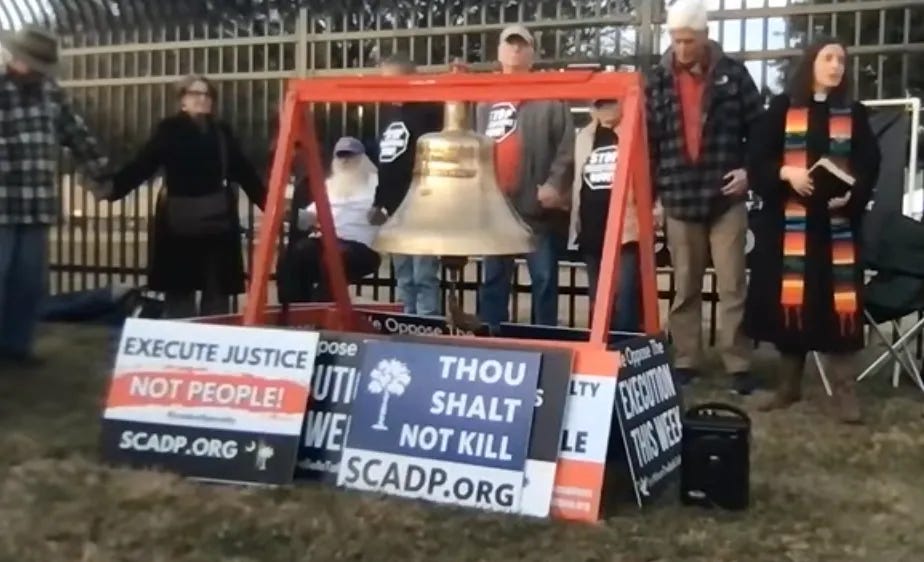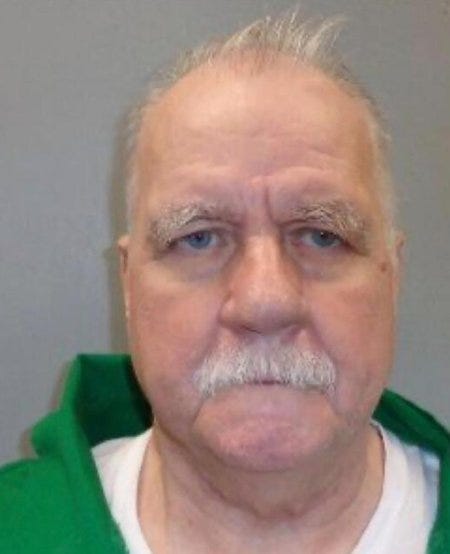"A Bloody Spectacle": South Carolina Executes Inmate By Firing Squad
It marked the first time in 15 years that an inmate has been put to death by a firing squad in the U.S.

This story has been updated.
By Gary Gately
A South Carolina man convicted of murdering his ex-girlfriend’s parents died Friday evening in a hail of bullets in a South Carolina prison’s death chamber, becoming the first person executed by a firing squad in the U.S. in 15 years.
Brad Keith Sigmon, 67, was pronounced dead at 6:08 p.m. EST at the Broad River Correctional Institution in Columbia, the state capital.
As he sat with his arms and legs bound to a metal chair, his head covered by a hood and a cloth white target with a red bull’s eye over his heart, three corrections employees simultaneously fired rifles from an opening in a wall 15 feet away, witnesses said.
Sigmon, the witnesses said, tensed when he was shot with bullets designed to shatter upon impact. A red stain appeared on his chest before he breathed his last.
“Brad’s death was horrifying and violent,” Gerald “Bo” King, one of Sigmon's attorneys, who witnessed the execution, said in a statement. “It is unfathomable that, in 2025, South Carolina would execute one of its citizens in this bloody spectacle.”
Before Sigmon’s death, King read a statement on his behalf, quoting several Bible passages, then adding: “I want my closing statement to be one of love and a calling to my fellow Christians to help us end the death penalty. Nowhere does God in the New Testament give man the authority to kill another man.”
The execution marked only the fourth by firing squad in the U.S. since reinstatement of the death penalty in 1976.
Earlier Friday, the U.S. Supreme Court rejected an appeal from Sigmon’s lawyers, who asked the court to delay his execution because South Carolina keeps much of its lethal injection drug information secret.
And South Carolina’s Republican governor, Henry McMaster, denied King’s attorneys their second request to grant him clemency.
Three anti-death penalty organizations, including the Catholic Mobilizing Network, also urged McMaster to spare Sigmon’s life in separate petitions that garnered a total of more than 18,000 signatures.
Minutes after Sigmon’s death, the Catholic Mobilizing Network posted on X (formerly Twitter): “The state of South Carolina has executed #BradSigmon by firing squad. Eternal rest grant unto him, O Lord. And may perpetual light shine upon him. Be merciful, O Lord, for we have sinned. Guide our steps forward toward a vision of justice that is rooted in human dignity.”
King said Sigmon chose the firing squad two weeks ago over the state’s only other two execution options: its “ancient electric chair,” which would '‘burn and cook him alive,” or a lethal injection, which could subject him to the same sort of prolonged suffering three South Carolina death row inmates he knew endured in executions since September. After their injections, they remained alive, strapped to a gurney, for as long as 20 minutes, suffering pulmonary edema, with blood and fluid filling their lungs, causing a sensation of drowning or suffocating, King said.
“The choice Brad faced today was impossible,” King said, calling death by firing squad “just as monstrous” as the electric chair and lethal injections. “Everything about this barbaric, state-sanctioned atrocity — from the choice to the method itself — is abjectly cruel,” he said. “We should not just be horrified. We should be furious.”
Sigmon’s attorneys claimed in an appeal last month that during his 2002 trial, a jury never heard evidence about his bipolar disorder or the brain damage, physical abuse and trauma he suffered as a child.
The attorneys said Sigmon had suffered a “manic and irrational episode akin to a psychotic break” when get murdered the parents of his ex-girlfriend, David and Gladys Larke, with a baseball bat in 2001 at their home in the northwest part of the state. The murders, which Sigmon never denied committing, came during a botched plot to kidnap his ex-girlfriend, Rebecca Barbare.
Before last night’s South Carolina execution, Utah had been the only state in the since 1997 to put inmates to death by firing squad. It did so in 1977, 1996 and 2010.
In recent years, states’ struggles to obtain lethal injection drugs have prompted more states to look to firing squads to execute inmates. Idaho, Mississippi and Utah also allow execution by firing squads, if lethal injection drugs cannot be obtained.

Abraham Bonowitz, executive director of Death Penalty Action, which also organized a petition urging McMaster to spare Sigmon’s life, noted that five other executions in five different states are scheduled over the next three weeks: by lethal injection in Texas on March 13; by nitrogen hypoxia suffocation in Louisiana on March 18; and by lethal injection in Arizona on March 19 and in Oklahoma and Florida on March 20.
Nitrogen hypoxia — first used to execute an inmate in Alabama in January 2024 and three times since, all in that state — has proved particularly controversial. Inmates breathe pure nitrogen gas, depriving them of oxygen and resulting in suffocation, sometimes leaving them writing and convulsing on the gurney for nearly 20 minutes, critics say. In November, the United Nations called for a ban on nitrogen gas executions, saying they violate international law prohibiting “cruel, inhuman or degrading treatment or punishment.”
While some execution methods may be viewed as more cruel, inhumane or barbaric than others, Bonowitz said: "For us, it's not about how we kill our prisoners. The concern we have is that we allow our government to conduct executions at all when the capital punishment system is so costly, discriminatory, inaccurate and disproportionately used."
Like others who seek to abolish the death penalty, Bonowitz points to extensive research demonstrating that it does not deter crime and is applied arbitrarily and disproportionately to Black people and people with mental illnesses, as well as to those convicted based on flawed forensic evidence.
Krisanne Vaillancourt Murphy, executive director of the Catholic Mobilizing Network, also points out that capital punishment runs counter to the teachings of the Catholic Church.
“Whether someone is shot, electrocuted, injected, or gassed, each and every execution extinguishes a God-given life with inherent dignity and worth,” Vaillancourt Murphy said. “Each and every execution is a blatant act of state-sanctioned violence.”
She quoted Pope Francis, who reaffirmed Church teaching his 2025 World Day of Peace message: “This penalty not only compromises the inviolability of life but eliminates every human hope of forgiveness and rehabilitation.”
South Carolinians for Alternatives to the Death Penalty said in a petition signed by more than 14,000 people urging McMaster to stop Sigmon’s execution that he had become a devout Christian who was deeply remorseful and a model prisoner who mentored and ministered to fellow death-row inmates.
“His case highlights the troubling flaws in the justice system’s treatment of people who’ve experienced childhood trauma and undiagnosed, inherited mental illness,” the petition stated. “Executing the man who Brad is today because of the tormented and ill man he was more than 20 years ago would accomplish nothing. It would only deprive the many people who have come to appreciate and even rely upon Brad—his family, prisoners, guards, and ministers—of his example and aid.”
The group’s executive director, the Rev. Hillary Taylor, a Methodist minister and Sigmon’s spiritual advisor for the past 4 1/2 years, said he suffered searing regret, remorse and grief over the pain he had inflicted on his victims’ family and had apologized to them.
But, Taylor told The Catholic Observer, Sigmon immersed himself in God’s word, studying and highlighting passages in his Bible and sharing insights with fellow inmates as the unofficial “Chaplain of Death Row.” He maintained close relationships with his two brothers, two sisters, son and grandson, as well as numerous pen pals outside the prison walls.
“Brad is somebody who had this capacity to say he’s sorry and be truly sorry,” Taylor said hours before Sigmon’s execution. “He speaks candidly of his regrets, but in the same breath about his faith in how God can do all kinds of miracles through all kinds of people who have done all kinds of harm, that God can accomplish God’s will through any person no matter who they are, no matter what kinds of sin, no matter what kind of life they’ve lived. And that’s the good news of salvation and what happens when we trust in the love of God to change our lives.”
Sigmon exulted with fellow inmates in their joys and consoled them in their sorrows, was quick with a joke and shared with Taylor his passion for nature and how much he had loved working for years as a tree surgeon.
“Every time you see a bird,” he told her, “I want you to think of me.
She does.
“What I learned from him is that we’re more than the worst thing that we’ve ever done or the worst thing that ever happened to us,” Taylor said.
After Sigmon’s execution, Taylor stood outside the gates of the prison with several other death penalty opponents and held his worn Bible.
She opened it to his favorite passage, Psalm 23, highlighted in yellow.
He had meditated on it every night in his bunk.
In his memory, Taylor recited words from the psalm:
“Even though I walk through the valley of the shadow of death, I will fear no evil, for you are with me.”



